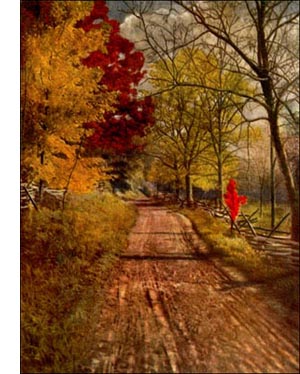Red Juniper or Red Cedar Juniper Tree
 Red Juniper, Red Cedar (Juniperus Virginiana, Linn.)Conical tree, compact when young, becoming loose and cylindrical or irregular when old; from a shrub to a tree 100 feet high and 5 feet trunk diameter; branches short, slender, ascending, becoming horizontal. Bark red, stringy, persistent; branches smooth. Wood soft, weak, close grained, red, fragrant. Buds minute, green. Leaves opposite, on old stems, 4-ranked; scale-like, bluegreen, closely appressed to twigs, which seem 4-angled; on new shoots, scattered, spiny, loose, awl shaped, 1/2 to 3/4 inch long, pale yellow-green. Flowers in April, May; terminal on side twigs, dioecious, rarely monoecious; staminate of q4 to 6 scales, each bear, ing several pollen sacs; pistillate of minute, paired, bluish, fleshy scales, bearing two ovules. Fruit a blue, glaucous berry, the size of a pea, ripening the first or second season and containing 1 to 4 seeds; flesh sweet, resinous. Preferred habitat, dry soil or peaty swamps. Distribution, east of the Rocky Mountains. Uses: Wood used largely for pails, pencils, chests and closets, sills and interior finishing, railroad ties and fence posts.
Red Juniper, Red Cedar (Juniperus Virginiana, Linn.)Conical tree, compact when young, becoming loose and cylindrical or irregular when old; from a shrub to a tree 100 feet high and 5 feet trunk diameter; branches short, slender, ascending, becoming horizontal. Bark red, stringy, persistent; branches smooth. Wood soft, weak, close grained, red, fragrant. Buds minute, green. Leaves opposite, on old stems, 4-ranked; scale-like, bluegreen, closely appressed to twigs, which seem 4-angled; on new shoots, scattered, spiny, loose, awl shaped, 1/2 to 3/4 inch long, pale yellow-green. Flowers in April, May; terminal on side twigs, dioecious, rarely monoecious; staminate of q4 to 6 scales, each bear, ing several pollen sacs; pistillate of minute, paired, bluish, fleshy scales, bearing two ovules. Fruit a blue, glaucous berry, the size of a pea, ripening the first or second season and containing 1 to 4 seeds; flesh sweet, resinous. Preferred habitat, dry soil or peaty swamps. Distribution, east of the Rocky Mountains. Uses: Wood used largely for pails, pencils, chests and closets, sills and interior finishing, railroad ties and fence posts.It is unfortunate that, whereas the true cedars are all in the Old-World genus Cedrus, the American genera, Thuya, Libocedrus, Chamaecyparis and Juniperus, each have one or more species to which the name is loosely applied. It would take a long while to unlearn the name "red cedar" for this familiar tree-to write with a juniper pencil; to put furs and woollens away in mothdiscouraging juniper chests. So hard it is to break a habit. The logical thing is to call this tree a juniper, as well as the other species of Juniperus, and so far reduce the confusion involved now every time the word cedar is mentioned.
This vagabond tree, familiar in abandoned farms and ragged fence rows of New England, is the same that grows from Nova Scotia to Georgia, and west to where the hills lift and the arid ridges become the foothills of the Rocky Mountains. A stunted tree covering the limestone plateaus of Tennessee, it is a towering pyramid of luxuriant green in the lower Mississippi Valley. Seashores of the East and South, and sterile soil on foothills of Eastern mountains, all show these scattered trees, small and bushy, or tall and compact. The berries are borne in profusion and are distributed by birds.
The leaves are 2-ranked, spiny, channelled, lined with white on new shoots and on young trees. The older parts of twigs show closely appressed scale-like leaves. Both types are found on every tree. In winter a rusty brown comes over the dark bluegreen of the foliage mass, but spring revivifies it.
The trunks are columnar and corrugated; they bare themselves by shedding the stringy brown bark in longitudinal strips. In lower Pennsylvania this is a shade tree of considerable popularity. It forms windbreaks in exposed situations, on the coast or inland, where most trees fall. The tree is planted profitably for posts and railroad ties in the Mississippi Valley States. Where trees can be had large enough for telegraph or telephone poles they command the highest prices, for the wood is one of the most durable. The Fabers have for generations maintained their own forests of this species in Germany to supply their pencil factories.
An interesting "fruit" of the red juniper, much larger and more luscious looking than the diminutive berries, is familiar to boys and girls under the name "cedar apple." A remarkable thing about these pulpy, jelly-like masses, with their yellow spurs, is that they come out on the twigs as suddenly as mushrooms. Still more astonishing is the fact that this parasitic fungus that makes itself at home on the red cedar utterly ignores all red cedars when its spores are germinating to produce the next generation. Only those that fall on apple trees live. They do not produce "apples" of any sort, but patches of yellow "apple rust" on leaves and fruit. Spores wafted away from these blotches germinate only when they fall on twigs of red cedar. They grow inside, and at fruiting time throw out the gelatinous cedar-apple mass whose spurs contain the spores.
This capricious "alternation of generations" is interestingly seen in wheat rust, whose alternate host is the common barberry. A third rust goes from birches to poplars and back again to birches each alternate year.